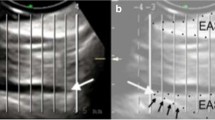Abstract.
We report a preliminary experience concerning the postoperative assessment of three patients who underwent gracilis neosphincter operation for severe fecal incontinence and were studied by computed tomography and anal endosonography soon after gracilis transposition and later after 6–8 weeks of neuromuscular training. Morphologic assessment was correlated with physiologic testing (manometry). Continence was satisfactorily improved in all patients. Both imaging techniques demonstrated the anatomy of the transposed muscle. Computed tomography also assessed lead placement onto the gracilis nerve root and the completeness of muscle transposition around the anal canal. Anal endosonography provided a more accurate assessment of the relation between the neosphincter and residual external sphincter.
Similar content being viewed by others
Author information
Authors and Affiliations
Additional information
Received: 3 April 1995/Accepted: 10 May 1995
Rights and permissions
About this article
Cite this article
Marano, I., Grassi, R., Donnianni, T. et al. CT and anal endosonography in the evaluation of electrically stimulated neoanal sphincter: a preliminary report. Abdom Imaging 21, 353–356 (1996). https://doi.org/10.1007/s002619900080
Issue Date:
DOI: https://doi.org/10.1007/s002619900080




